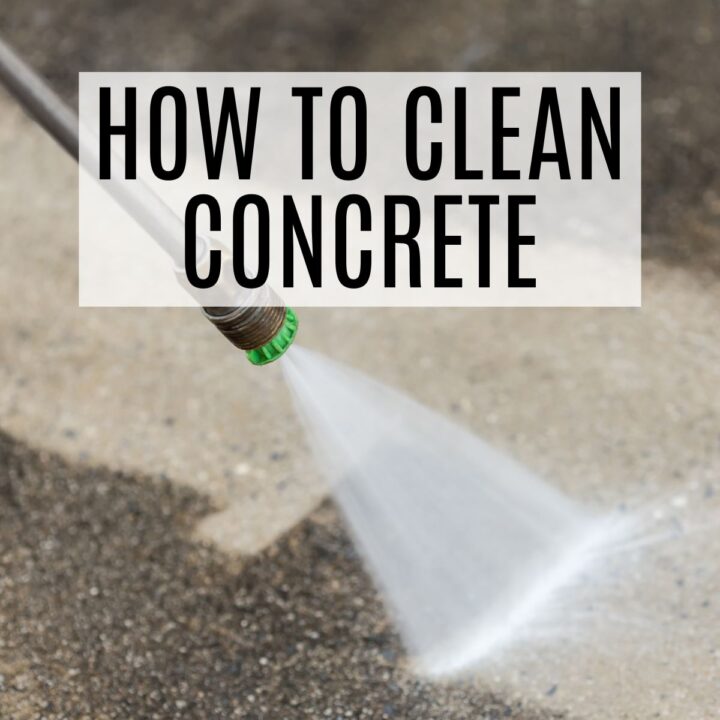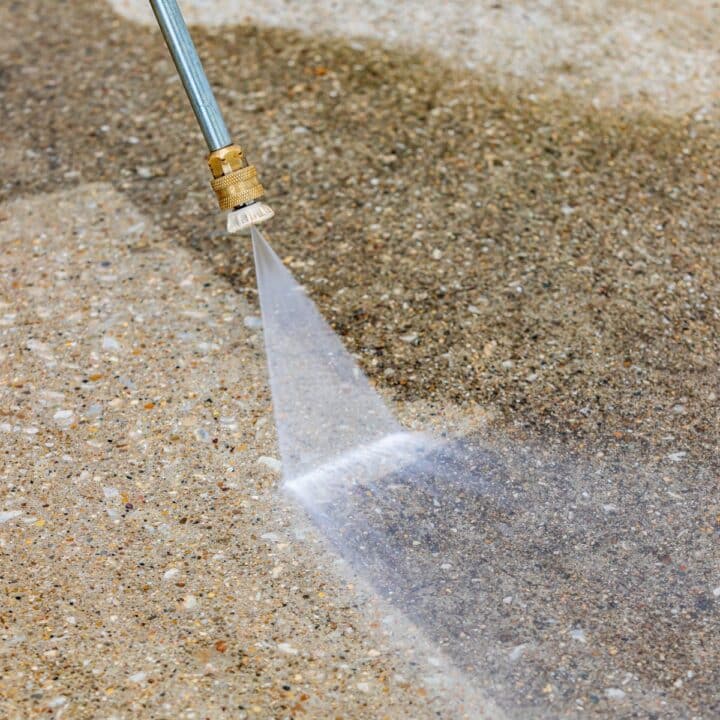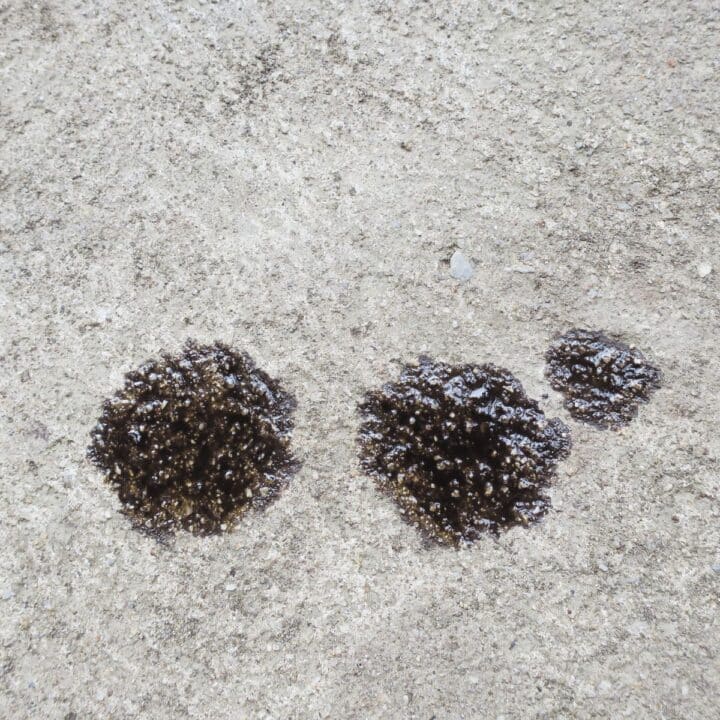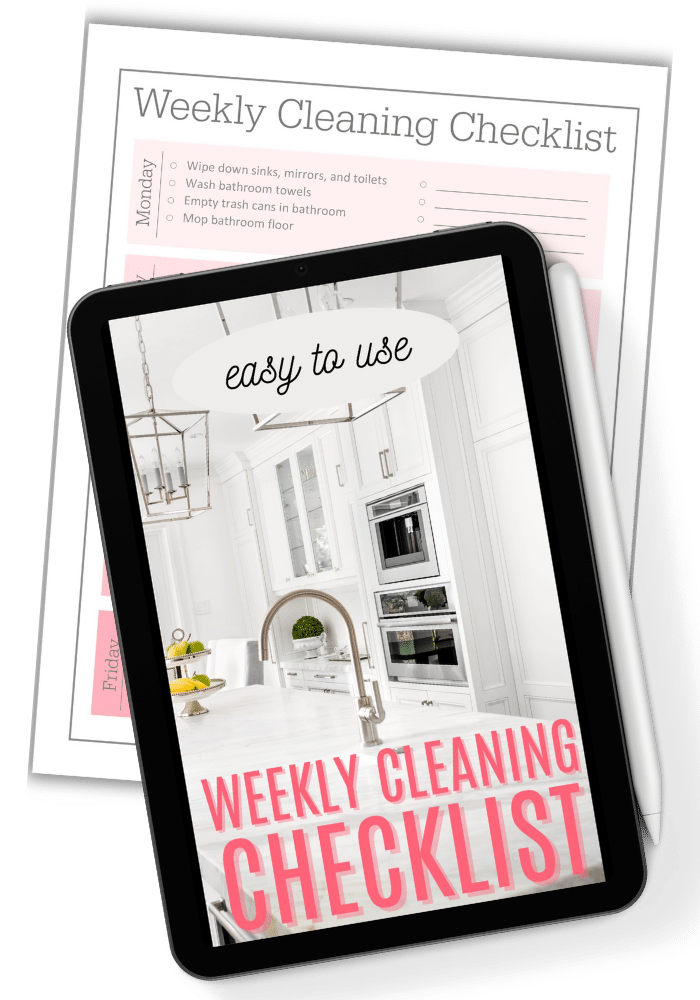Inside: Learn the best ways to clean your cement patio with and without a pressure washer using our simple cleaning process!

Concrete patios are tough and super versatile, which is why they're such a hit for outdoor spaces. But let's face it—over time, they can start to look a little worse for wear with dirt, mold, stains, and mildew taking over.
Yikes! To keep your patio looking fresh and fabulous, regular cleaning is a must. Don't worry, though! This guide is here to show you the easiest and best ways to make sure your concrete patio stays in tip-top shape.
Concrete may look tough, but it's actually pretty absorbent! It soaks up dirt, grime, oil, and all kinds of mess, which can lead to stains, discoloration, and even damage over time.
Keeping it clean doesn’t just make your patio look awesome—it also helps it last longer. Regular maintenance and cleaning ensures your concrete patio stays strong and gorgeous for years to come, so you can keep enjoying your outdoor space without worry!
While you are cleaning up your outdoor space see how we keep the mosquitos away naturally and how to clean your patio furniture using Borax.
Table of contents
- Before Starting
- What You'll Need
- Best Methods for Cleaning Concrete Patios
- Cleaning With Warm Water and Soap
- Deep Cleaning with a Pressure Washer
- Removing Tough Stains
- Can You Use These Methods on Concrete Pavers or Garage Floors?
- When is the Best Time of Year to Clean Concrete?
- Common FAQs About Concrete Cleaning
- More Cleaning Tips and Hacks

Before Starting
Sweep or use a leaf blower to blow off loose debris such as leaves, twigs, and dirt. Then remove all decorative items such as nearby plants, outdoor furniture, grills, etc.
If you are using the cleaning solution on your concrete driveway move vehicles to the street.
What You'll Need
Depending on which method you choose for your concrete surface, the supplies will vary. However, these are the most common to get started.
- Garden Hose
- Power washer - this is only if you already own one.
- Stiff Brush
- Bucket
Best Methods for Cleaning Concrete Patios
There are plenty of easy and effective ways to clean a concrete patio, and the method you choose depends on just how dirty or stained your patio has gotten.
No worries—we’ve got you covered! Check out the most popular cleaning techniques below, so you can find the perfect one to bring your patio back to life.

Cleaning With Warm Water and Soap
In a bucket, mix warm water with a few drops of mild dish soap (Dawn is our favorite brand).
Dip the scrub brush into the soapy water and scrub the concrete in sections, paying particular attention to heavily soiled areas.
Use the hose to rinse the soap off the surface. Be sure to remove all soap residue to prevent streaking.
Allow the patio to air dry.

Deep Cleaning with a Pressure Washer
For more thorough cleaning or heavily stained surfaces, a pressure washer is the best way and most efficient, especially if you have stubborn stains.
Connect the pressure washer to a water source and select the appropriate nozzle for cleaning concrete (a 25-degree nozzle is ideal for most patios).
If your pressure washer has a detergent tank, fill it with a concrete-safe detergent for more effective cleaning.
Starting from one corner of the patio, use smooth, overlapping strokes to clean the surface. Keep the nozzle at least 6-12 inches from the concrete to avoid damage.
After washing, rinse off any remaining detergent or dirt and allow the patio to air dry.

Removing Tough Stains
Some stains, such as oil, rust, or mildew stains, may require specialized patio cleaner beyond soap and water or pressure washing. You will also want to test in an inconspicuous area first before cleaning the entire surface.
For Oil Stains:
Sprinkle cat litter or an absorbent material over the oil stain and let it sit for 24 hours.
After sweeping up the absorbent material, apply a degreaser to the stain and scrub it with a stiff brush.
Rinse the area thoroughly with a hose.
For Rust Stains:
Pour lemon juice or white vinegar directly onto the rust stain and let it sit for 10-15 minutes.
Scrub the area with a stiff brush and rinse with clean water.
For Mold and Mildew:
Mix a solution of 1 part bleach to 10 parts water.
Wear protective eyewear and gloves, and scrub the mold or mildew using bleach.
Rinse the patio with water after scrubbing.
Can You Use These Methods on Concrete Pavers or Garage Floors?
Yes, many of the methods used to clean your patio surface can also be applied to concrete pavers, garage floors, and basement floors, but there are some important considerations for each surface type.
Cleaning Concrete Patio Pavers
- Pressure Washing: Pressure washing is effective for cleaning concrete pavers, especially for removing loose dirt, moss, and weeds from the joints between the pavers. However, use a pressure washer with a PSI of around 1,500–2,000 to avoid dislodging the pavers or damaging the joints.
- Mild Detergent and Scrubbing: Similar to cleaning patios, you can use a solution of mild dish soap and water for general cleaning. Apply the solution, scrub with a brush, and rinse thoroughly.
- Stain Removal: For specific stains like oil or rust, use the same targeted cleaning methods. For oil, apply a degreaser; for rust, use vinegar or lemon juice.
- Sealing Pavers: After cleaning, it’s a good idea to reseal the pavers to protect them from future stains and maintain their appearance. Paver sealers also help prevent weed growth in the joints.
Cleaning Garage Floors
- Degreasers: Garage concrete floors are often exposed to oil, grease, and tire marks. A commercial degreaser or concrete cleaners are ideal for breaking down these substances. Apply the degreaser, let it sit for the recommended time, then scrub with a stiff brush.
- Pressure Washing: Pressure washing is effective for garage floors, but be cautious of directing water toward walls or inside areas. Use the same pressure levels as on patios (2,500–3,000 PSI).
- OxiClean or Bleach Solutions: These can also be used on the garage floor for general cleaning or mold removal. However, it's important to rinse thoroughly and ensure the floor dries completely before parking vehicles or placing items back in the garage.
- Tough Stains: For stubborn stains, such as oil spots that have soaked into the concrete, an absorbent material like cat litter or a stronger degreaser may be needed. Rust stains can be treated similarly to outdoor concrete with lemon juice or vinegar.
Special Considerations
- Joint Integrity: When cleaning pavers, avoid using too much pressure or harsh chemicals that could erode the sand or materials in the joints between pavers.
- Drainage in Garages: When using water-based cleaning methods in garages, ensure the water drains properly to avoid standing water, which can lead to mold or damage.

Grab Your FREE Printable
Receive a simple and easy-to-use weekly cleaning printable delivered to your inbox!
When is the Best Time of Year to Clean Concrete?
The best time to clean concrete surfaces, such as patios, driveways, or garage floors, is typically during the spring and fall. The warmer months offer optimal weather conditions for cleaning and maintaining your concrete.
Why Spring and Fall Are Ideal:
- Moderate Temperatures:
- Spring and fall provide mild, comfortable temperatures, which make it easier to work outdoors without extreme heat or cold.
- Cleaning solutions also work more effectively when it's not too hot or too cold, as extreme temperatures can cause cleaning agents to evaporate too quickly or freeze in winter weather.
- Post-Winter Cleanup (Spring):
- After winter, concrete surfaces often accumulate dirt, salt, and grime from snow, ice, and foot traffic. Spring cleaning helps remove these substances and prevent long-term damage like surface pitting or staining.
- It’s also a good time to inspect for cracks or other damage caused by freeze-thaw cycles during winter.
- Pre-Winter Preparation (Fall):
- Cleaning in the fall prepares your concrete for winter by removing dirt, leaves, and other organic debris that can cause stains or mold growth if left through the cold months.
- Sealing the concrete after cleaning in the fall adds an extra layer of protection against snow, ice, and freezing temperatures.
Additional Considerations:
- Avoid Extreme Weather:
- It's best to avoid cleaning during very hot summer days or freezing winter temperatures. In summer, the heat can cause water and cleaning solutions to evaporate too quickly, while freezing winter temperatures can make cleaning difficult and potentially damage the concrete if water freezes in cracks.
- Dry Conditions:
- Choose a day when rain is not expected so that your cleaning efforts aren’t washed away. Allow enough time for the concrete to dry completely after cleaning.
By cleaning concrete in the spring and fall, you can keep it in good condition and ready to withstand the demands of each season.
Preventative Maintenance for a Clean Patio
After you've cleaned your patio, it's a good idea to start taking preventative measures to keep it looking its best.
1. Seal the Concrete
Applying a concrete sealer can help protect the surface from future stains and damage. Sealers create a barrier that repels water, oil, and other contaminants, making the surface easier to clean in the future. For outdoor concrete, a penetrating or acrylic sealer is usually the best option.
2. Sweep Regularly
Regularly sweeping your patio prevents the buildup of dirt and debris. This is especially important during the fall, when leaves and organic material can accumulate quickly.
3. Clean Spills Immediately
If you spill oil, grease, or food on your patio, clean it up right away to prevent staining. The longer these substances sit on the surface, the harder they are to remove.
Common FAQs About Concrete Cleaning
For general maintenance, it's recommended to clean your concrete patio at least twice a year—once in the spring and once in the fall. However, if your patio is has a lot of regular foot traffic or exposed to more dirt, stains, or weathering, more frequent cleanings may be necessary. Regular sweeping and spot cleaning can also help maintain its appearance between deep cleanings.
Yes, bleach can be used to clean concrete patios, especially for removing mold and mildew. However, it should be diluted properly (1 part bleach to 10 parts water) and used with care. Be sure to wear protective gloves and goggles, and thoroughly rinse the area with water afterward to prevent any damage to surrounding plants or surfaces.
The best cleaner depends on the type of stain you're dealing with:
For general dirt and grime, mild dish soap mixed with water works well.
If you have oil stains, a degreaser is most effective.
When it comes to rust stains, lemon juice or white vinegar is a good option.
For mold or mildew, a bleach solution or a commercial mold remover works best.
Yes, pressure washing can potentially damage your concrete if not done correctly. Using a pressure washer with too high of a PSI (pounds per square inch) or holding the rotary nozzle too close to the surface can cause chipping or cracking. To avoid damage, use a pressure washer with a PSI between 2,500 and 3,000 and keep the nozzle at least 6-12 inches away from the concrete surface.
To prevent stains on your concrete patio:
Apply a concrete sealer after cleaning. This will create a protective barrier against water, oil, and other contaminants.
Clean up spills immediately, especially oil or food-related stains.
Regularly sweep and rinse your patio to remove dirt and debris before they can cause staining.
Sealing is not mandatory but highly recommended. A sealer provides a protective layer that makes future cleaning easier and helps prevent stains, water damage, and general wear and tear. Most sealers need to be reapplied every 1-3 years, depending on exposure to the elements and foot traffic.
Keeping your concrete patio clean not only makes your outdoor living space look amazing but also helps the concrete last longer. Whether you're doing a quick sweep, tackling stubborn stains, or going all out with a pressure washer, these steps will help you get the job done right. Plus, a little regular care—like sealing and sweeping—means less work later and a patio that stays picture-perfect!
By giving your patio some TLC, you'll keep it looking fresh and functional for years to come. A little effort now goes a long way!


Leave a Reply